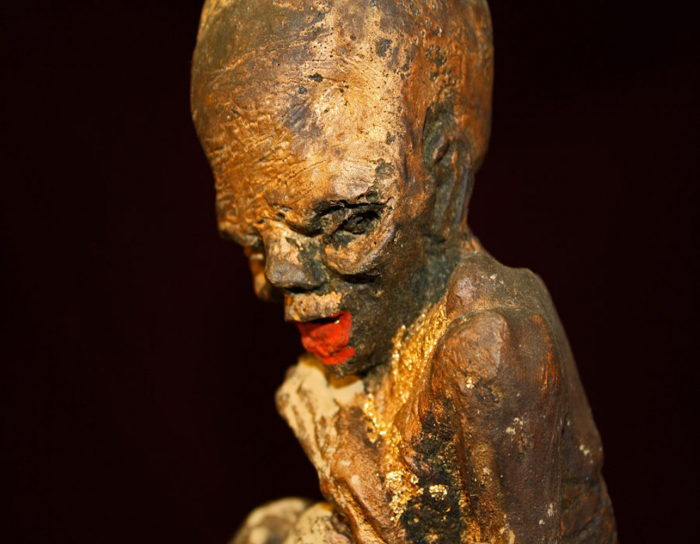Amulets exist since the advent of our species.
These magical objects, to which people attribute supernatural virtues, are in charge of protecting their owners and guaranteeing them good luck. Considered as expressions of faith by some people and of superstition by others, omnipresent in spite of our secularized society, they range from the lucky charms held tight by the athletes before a competition to the crosses worn around the neck, from the pendants with Eastern symbols and inscriptions to the colourful horn-shaped amulets of the Neapolitan tradition.
After all, amulets seem to be the rather harmless expression of a universal desire: the desire to get a bit of happiness.
But not all amulets are harmless.
Kuman Thong literally means “the sacred golden child”.
A household divinity for Thai popular religion, entrusted for the wellness and prosperity of the family, it is idolized since the farthest past; it has survived the advent of Buddhism, alongside the official practices.
Its effigy, made of wood, stone or metal and plated in gold, depicts the body of a child. It is kept inside the house, and different types of offerings are made to the spirit inside it: sweet candles, chocolate candies, fresh milk, rice, hard-boiled eggs, etc. The Kuman Thong is seen as a real adopted child, who must be cuddled and protected from any tension within the family.
So far, so good.
But the original procedure to create this powerful amulet didn’t imply the use of a wooden statuette: the basic ingredient was a real foetus, who had died inside its mother’s womb.
The ancient manuscripts gave the shaman precise instructions on how to cut the womb and extract the little body, which was to be brought to a cemetery as soon as possible; here the spirit of Kuman Thong was conjured by means of a specific ceremony. Once the tiny corpse was “possessed” by the divinity, it had to be dried out on the fire.
Then the shaman started to paint it with the traditional Ya Lak lacquer, and covered it with gold foil. The amulet was ready.
You might be tempted to consider a magical practice like this as a fantasy: even Western grimoires contained picturesque and macabre recipes that seem deliberately studied to be impossible to realize. Now they sound even comical – “tongues of basilisk, sweat of a hanged person...” – some kind of Addams Family stuff.
And yet Kuman Thongs were absolutely real. So real that even nowadays, every now and then, some authentic ones appear on the market. And there are even people who try to manufacture them according to the traditional method.
In 2008 a monk was expelled by the Buddhist community because he had dried out the corpse of a newborn.
In 2012 the Bangkok police found six roasted foetuses covered in gold in the hotel room of the English citizen of Thai origin Chow Hok Kuen, ready to be sold to respectable businessmen from Hong Kong. The 28-year-old man stated that for a single “golden child” his clients were willing to pay 200,000 baht (about 6300 dollars).
The worst spent money ever: the merchant was arrested for trafficking of human remains, which proved once and for all that Kuman Thongs are not exactly a guarantee as lucky charms.

